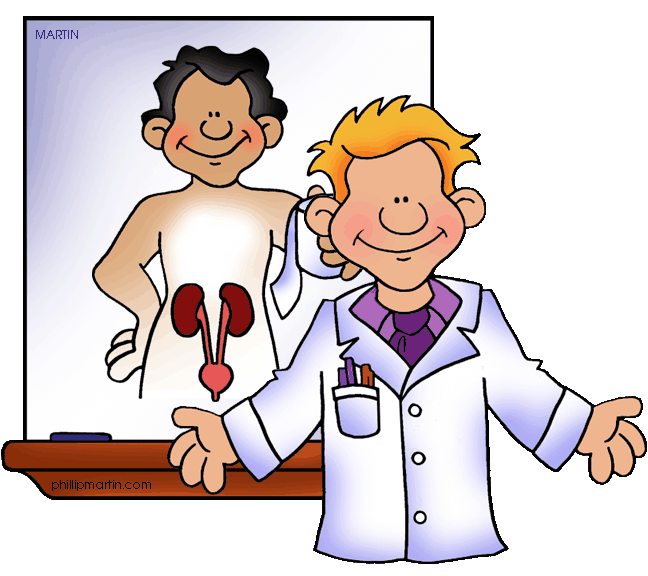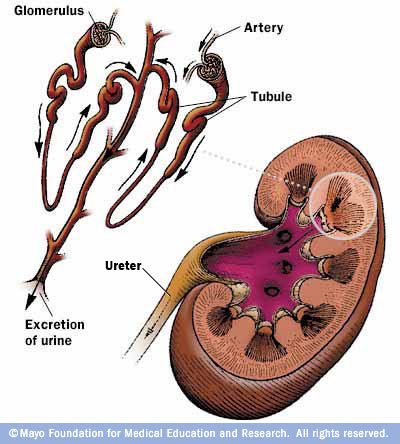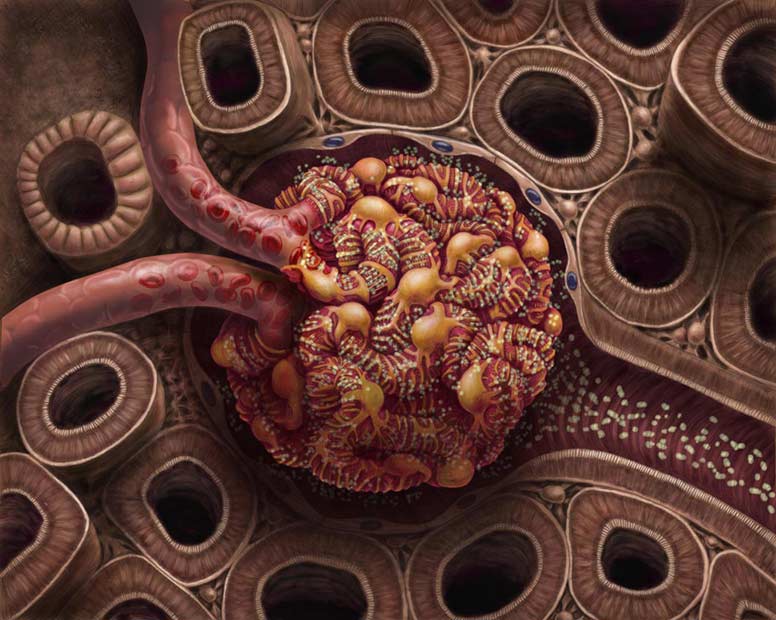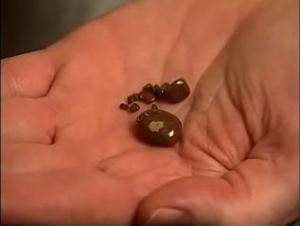The Excretory System:
Diseases
Diseases
Kidney Stones
What is it?
Kidney Stones are small deposits of minerals and acid salts that harden into crystals in the kidneys. They are painful but usually cause no lasting damage.
Causes
When urine becomes too concentrated, minerals crystalize and stick together, forming kidney stones. But what causes the increased concentration? It depends on the type of kidney stone it is. Calcium stones are the most common kind, consisting of 80% of all kidney stones. Calcium stones are caused by an increased amount of calcium oxalate in the kidneys, which happens when there is a lot of vitamin D intake, a metabolic disorder, or a bypass surgery. Struvite stones are caused by infections, and they grow very big, very fast. Uric acid stones form when you don't drink enough fluids, loose too much fluid, have a high-protein diet, or have gout. Cystine stones form in people with Cystinuria, a hereditary disorder which causes the kidneys to excrete too much of some amino acids. There are other types of kidney stones, but they are very rare.
Symptoms
-Severe pain on back, below ribs
-pain during urination
-pink, brown, or red urine
-cloudy urine
-bad-smelling urine
-nausea and vomiting
-consistant urge to urinate
-urinating more than usual
-fever and chills (if caused by infection)
-pain in waves or pain of varying degrees
-pain that spreads to the lower abdomen and/or groin
Treatments
There are many different treatments for kidney stones, depending on the type of kidney stone you have.
Minimal Symptom Kidney Stones:
-drink a lot of water, about 2-3 quarts per day, to flush out the stone
-pain relievers: ibuprofen, acetaminophren, naproxen sodium, etc. (AKA Motrin and Advil, Tylenol, Aleve)
-medical therapy-alphablockers relax the ureter muscles and allow the stone to pass faster and with less pain
Kidney Stones Caused by Infection, Are too Large, or Inflict Bleeding:
-Extracorporeal Shock Wave Lithotripsy (SWL)-sound waves make strong vibrations to break the stone into tiny pieces that can be passed in urine
-Percultaneous Nephrolithotomy-this is a surgery to remove the kidney stone; small telescopes and instruments are used through a small incision on the back to remove the stone; recovery time is 2-3 days in the hospital; anesthesia is needed
-Ureteroscopes (thin lighted tube with a camera on the end) pass through the urethra and bladder into the ureter, the docter can locate the stone and then break it with snare tools into passable pieces; to decrease swelling and increase healing a stent (small tube) is placed in the ureter
-Parathyroid Gland Surgery- Sometimes kidney stones are caused by an overactive parythyroid gland and it makes too much parathyroid hormone, which causes an increase in calcium leverls. The increase in the hormone is sometimes caused by a tumor forming in one of the glands, so doctors can remove the tumor to stop the making of kidney stones.
Glomerulonephritis
What is it?
Glomerulonephritis (AKA glomerular disease) is the inflamming of the glomeruli, which are tiny filters in the nephrons of the kidneys that remove extra fluids and wastes from the blood and put it into urine. There are two kinds, acute (sudden) or gradual. On its own, Glomerulonephritis is called Primary Glomerulonephritis. When the disease is caused by another disease (i.e. diabetes, Lupus), it is called Secondar Glomerulonephritis.
Causes
There are multiple causes of Glomerulonephritis, so here is a list of the most common:
Infections:
Strep Throat-extra antibodies settle in the glomeruli and cause it to become inflammed
Viral Infections-HIV, Hepatitis B and C
Bacterial Endocarditis-bacteria spread through the body and set in the heart valves (we know there is a connection between this and Glomerulonephritis, we just haven't discovered what it is yet!)
Immune Diseases:
Lupus-a chronic inflammatory disease
Goodpasture's Syndrome-rare lung disorder that mimics pneumonia, causes Glomerulonephritis and bleeding into lungs
Immunoglobulin A Nephropathy (IgA)- recurring blood in urine caused by when IgA deposits in the Glomerulonephritis
Vasculitis (inflammation of blood vessels):
Polyarteritis-small and medium sized blood vessels inflammed all over the body
Wegener's Granulomatosis-small and medium sized blood vessels inflammed in lungs and kidneys
Scarring in the glomeruli:
caused by high blood pressure, Diabetic Kidney Disease, Flocal Segmental Glomerulosclerosis
Symptoms
-pink colored urine
-foamy urine
-high blood pressure
-fluid retention with swelling in the face, hands, feet, and/or abdomen
-fatigue from anemia or kidney failure
Treatments
Treatments of Glomerulonephritis depend on the type. Some less severe forms require no treatment at all, and eventually fix themselves. Sometimes it is best to treat the underlying cause of Glomerulonephritis. For instance, High Blood Pressure is treated with medicines, diuretics (which cause an increase in urine production), Angiotensin-converting Enzyme Inhibitors, or Angiotensin II Receptor Agonsits. Strep Throat and other bacteria can be cured through the use of antibiotics. Lupus and vasculitis can be treated using corticosteroids and immune-suppressing drugs. IgA Nephropathy is cured by fish oil supplements and immune suppressing drus. Goodpasture's Syndrome is treated with Plasmapheresis, the mechanical process that takes antibodies out of the body and replaces it with donated plasma or another fluid. However, if Glomerulonephritis results in kidney failure, the only options are dialysis or a kidney transplant. Dialysis requires the patient to be hooked up to a dialysis machine that functions as an artificial kidney for 4-6 hours a day, three times a week. Kidney transplants can be from a living donor (we only need one kidney) or a dead one, but the waiting list is very long.
What is it?
Kidney Stones are small deposits of minerals and acid salts that harden into crystals in the kidneys. They are painful but usually cause no lasting damage.
Causes
When urine becomes too concentrated, minerals crystalize and stick together, forming kidney stones. But what causes the increased concentration? It depends on the type of kidney stone it is. Calcium stones are the most common kind, consisting of 80% of all kidney stones. Calcium stones are caused by an increased amount of calcium oxalate in the kidneys, which happens when there is a lot of vitamin D intake, a metabolic disorder, or a bypass surgery. Struvite stones are caused by infections, and they grow very big, very fast. Uric acid stones form when you don't drink enough fluids, loose too much fluid, have a high-protein diet, or have gout. Cystine stones form in people with Cystinuria, a hereditary disorder which causes the kidneys to excrete too much of some amino acids. There are other types of kidney stones, but they are very rare.
Symptoms
-Severe pain on back, below ribs
-pain during urination
-pink, brown, or red urine
-cloudy urine
-bad-smelling urine
-nausea and vomiting
-consistant urge to urinate
-urinating more than usual
-fever and chills (if caused by infection)
-pain in waves or pain of varying degrees
-pain that spreads to the lower abdomen and/or groin
Treatments
There are many different treatments for kidney stones, depending on the type of kidney stone you have.
Minimal Symptom Kidney Stones:
-drink a lot of water, about 2-3 quarts per day, to flush out the stone
-pain relievers: ibuprofen, acetaminophren, naproxen sodium, etc. (AKA Motrin and Advil, Tylenol, Aleve)
-medical therapy-alphablockers relax the ureter muscles and allow the stone to pass faster and with less pain
Kidney Stones Caused by Infection, Are too Large, or Inflict Bleeding:
-Extracorporeal Shock Wave Lithotripsy (SWL)-sound waves make strong vibrations to break the stone into tiny pieces that can be passed in urine
-Percultaneous Nephrolithotomy-this is a surgery to remove the kidney stone; small telescopes and instruments are used through a small incision on the back to remove the stone; recovery time is 2-3 days in the hospital; anesthesia is needed
-Ureteroscopes (thin lighted tube with a camera on the end) pass through the urethra and bladder into the ureter, the docter can locate the stone and then break it with snare tools into passable pieces; to decrease swelling and increase healing a stent (small tube) is placed in the ureter
-Parathyroid Gland Surgery- Sometimes kidney stones are caused by an overactive parythyroid gland and it makes too much parathyroid hormone, which causes an increase in calcium leverls. The increase in the hormone is sometimes caused by a tumor forming in one of the glands, so doctors can remove the tumor to stop the making of kidney stones.
Glomerulonephritis
What is it?
Glomerulonephritis (AKA glomerular disease) is the inflamming of the glomeruli, which are tiny filters in the nephrons of the kidneys that remove extra fluids and wastes from the blood and put it into urine. There are two kinds, acute (sudden) or gradual. On its own, Glomerulonephritis is called Primary Glomerulonephritis. When the disease is caused by another disease (i.e. diabetes, Lupus), it is called Secondar Glomerulonephritis.
Causes
There are multiple causes of Glomerulonephritis, so here is a list of the most common:
Infections:
Strep Throat-extra antibodies settle in the glomeruli and cause it to become inflammed
Viral Infections-HIV, Hepatitis B and C
Bacterial Endocarditis-bacteria spread through the body and set in the heart valves (we know there is a connection between this and Glomerulonephritis, we just haven't discovered what it is yet!)
Immune Diseases:
Lupus-a chronic inflammatory disease
Goodpasture's Syndrome-rare lung disorder that mimics pneumonia, causes Glomerulonephritis and bleeding into lungs
Immunoglobulin A Nephropathy (IgA)- recurring blood in urine caused by when IgA deposits in the Glomerulonephritis
Vasculitis (inflammation of blood vessels):
Polyarteritis-small and medium sized blood vessels inflammed all over the body
Wegener's Granulomatosis-small and medium sized blood vessels inflammed in lungs and kidneys
Scarring in the glomeruli:
caused by high blood pressure, Diabetic Kidney Disease, Flocal Segmental Glomerulosclerosis
Symptoms
-pink colored urine
-foamy urine
-high blood pressure
-fluid retention with swelling in the face, hands, feet, and/or abdomen
-fatigue from anemia or kidney failure
Treatments
Treatments of Glomerulonephritis depend on the type. Some less severe forms require no treatment at all, and eventually fix themselves. Sometimes it is best to treat the underlying cause of Glomerulonephritis. For instance, High Blood Pressure is treated with medicines, diuretics (which cause an increase in urine production), Angiotensin-converting Enzyme Inhibitors, or Angiotensin II Receptor Agonsits. Strep Throat and other bacteria can be cured through the use of antibiotics. Lupus and vasculitis can be treated using corticosteroids and immune-suppressing drugs. IgA Nephropathy is cured by fish oil supplements and immune suppressing drus. Goodpasture's Syndrome is treated with Plasmapheresis, the mechanical process that takes antibodies out of the body and replaces it with donated plasma or another fluid. However, if Glomerulonephritis results in kidney failure, the only options are dialysis or a kidney transplant. Dialysis requires the patient to be hooked up to a dialysis machine that functions as an artificial kidney for 4-6 hours a day, three times a week. Kidney transplants can be from a living donor (we only need one kidney) or a dead one, but the waiting list is very long.


Here
you can see the different sizes of kidney stones. Click to enlarge.
Fun Fact! Calcium oxalate is a
naturally occuring substance that is found in large amounts in fruits,
vegetables, nuts, and
chocolate.
Fun Fact!
When a patient gets a kidney transplant, the old kidney is not taken out! The new kidney is just put on top of it.
When a patient gets a kidney transplant, the old kidney is not taken out! The new kidney is just put on top of it.

Here is a diagram of the kidney, showing
where the glomeruli are located within the nephrons. Click the picture to
englarge.
This medical illustration gives you an idea
of what a glomerulus looks like. Click to englarge.

